Day 4 of a 5 day Autumn Tour today. Having headed west yesterday, we decided to go the other way along the coast this morning. It was glorious weather to be out on the coast – sunshine, blue skies and light winds. It could almost have been summer!
We drove along to Cley first and headed out to walk around the south side of the reserve. We could hear Bearded Tits calling almost immediately – there was a lot of ‘pinging’ coming from the reedbed this morning. As we walked along the path, suddenly four Bearded Tits flew up from the reeds and started climbing up into the sky. This is the time of year when little parties of them disperse along the coast but they could not pluck up the courage to move today and eventually dropped back into the reeds. It was perfect conditions for looking for Bearded Tits – sunny and still.
We walked round to where we thought we might be able to see them better and, between more bouts of ‘pinging’, we saw eight Bearded Tits flying around the tops of the reeds together. They kept flying round and dropping into the reeds, but eventually they landed and climbed up into the tops where we could get them in the scope. They looked amazing in the morning sun, with three cracking males with grey heads and drooping black moustaches (beards!).
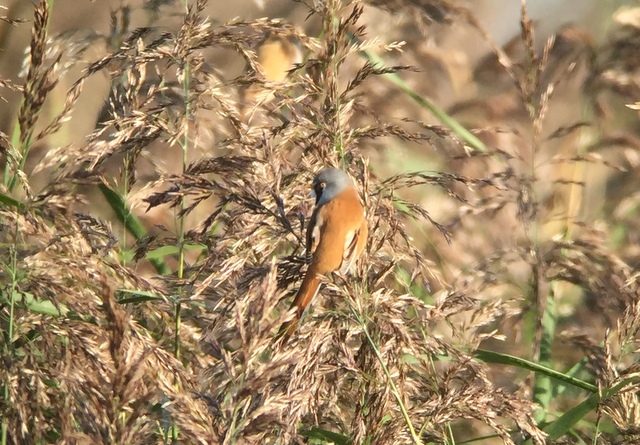 Bearded Tit – cracking views of at least 8 today, including 3 stunning males
Bearded Tit – cracking views of at least 8 today, including 3 stunning males
Nearby, a female Marsh Harrier was perched in the top of one of the bushes in the reedbed. We got her in the scope and enjoyed amazing views of her too. She sat there for a while looking round, then started calling. A Magpie came to investigate but just hopped around in the bush below her and she ignored it. She seemed to yawn a couple of times, opening her bill and stretching her neck up – she looked like she might be calling, but though we had heard her earlier we didn’t when she did this.
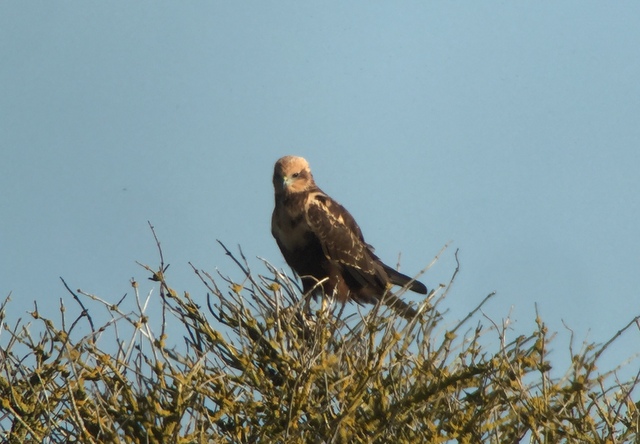
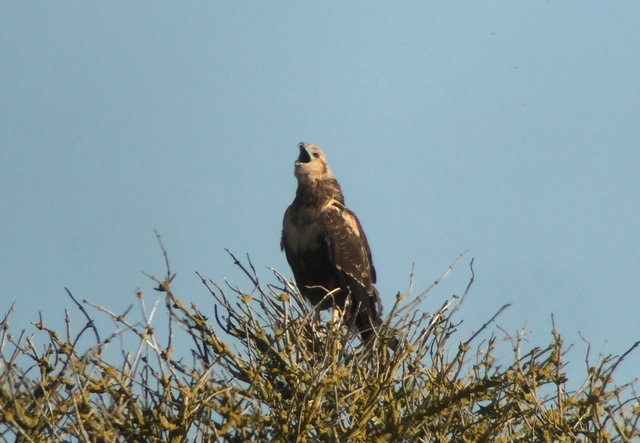 Marsh Harrier – stunning views of this female preening & yawning
Marsh Harrier – stunning views of this female preening & yawning
She preened for a while and stretched, hanging out her left wing at one point, giving us a great view of the pale leading edge to the inner wing shown by adult female Marsh Harriers. Stunning views!
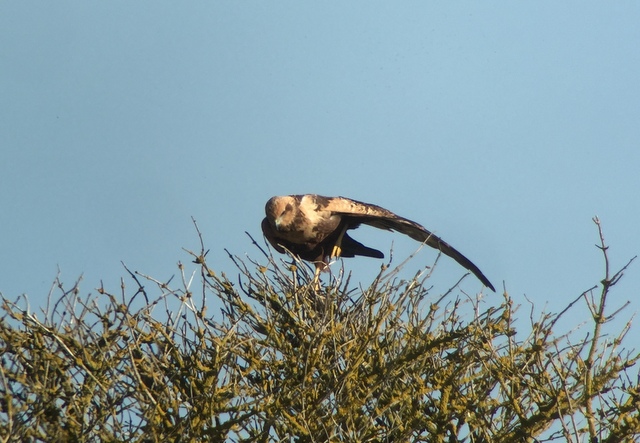 Marsh Harrier – stretching to show us the pale leading edge to the wing
Marsh Harrier – stretching to show us the pale leading edge to the wing
The water levels on the reserve have been high in the last couple of weeks, which is good for the ducks arriving for the winter, but with all scrapes in a similar state it means there have not been so many waders. We had a quick look at Pat’s Pool and could see that there was still a lot of water. There were lots of birds present – especially ducks, mostly Wigeon and Teal, with a few Shoveler and a couple of Pintail. Most of the drakes are still in drab eclipse plumage, but a drake Teal was more advanced in its moult and already showing a rather smart head pattern. A single Gadwall was also a smart drake.
There were lots of larger waders present, but limited variety – a large mob of Black-tailed Godwits and lots of Lapwing. Amongst them were a few Ruff. They were mostly adults, with whiter underparts and white-scalloped grey-brown uppers. There was only one much browner juvenile.
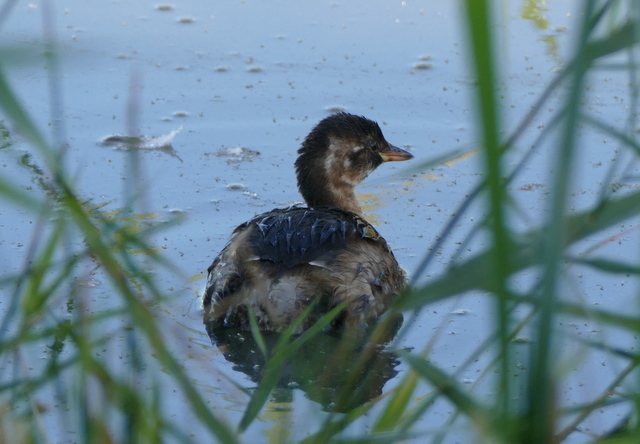 Little Grebe – catching lots of fish in the channel in front of the hide
Little Grebe – catching lots of fish in the channel in front of the hide
There was a young Little Grebe fishing in the channel right in front of the hide. It seemed to be doing very well, catching lots of small fish. Some of the group saw a Water Rail briefly along the channel as well, while the rest of us were still bewitched by the Bearded Tits.
 Marsh Harrier – seen off by the Lapwings
Marsh Harrier – seen off by the Lapwings
When the Marsh Harrier had finished stretching and preening, she flew out across the reedbed and circled around the back of the scrape. She didn’t seem to be hunting – perhaps she did it just to cause mayhem in the birds loafing on Pat’s Pool. She certainly caused a stir, as all the birds over the back of the scrape took to the air. Several Lapwing set off after her, but she didn’t really seem to be perturbed as she drifted back to the reedbed. All the ducks and waders quickly settled again. A single Common Snipe had obviously been brought out by the activity, as it suddenly appeared out in the middle as everything else landed.
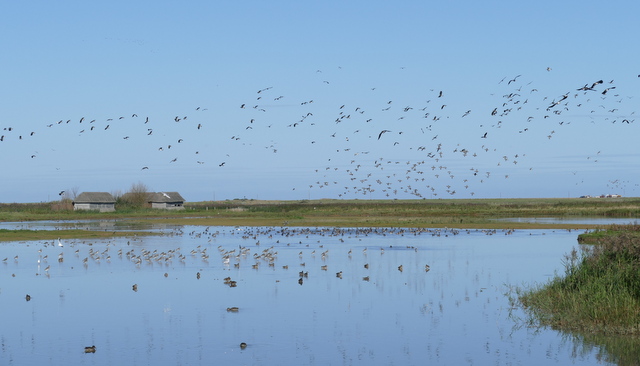 Pat’s Pool – the Marsh Harrier stirred up all the birds as it circled over
Pat’s Pool – the Marsh Harrier stirred up all the birds as it circled over
With not much else to tempt us out onto the reserve, we decided to move on further east along the coast. A Yellow-browed Warbler had been reported again this morning at Walsey Hills – it had been present for a few days but had been elusive earlier on in its stay. We popped in to have a look, but quickly discovered that it hadn’t been seen or heard of since early this morning. There were a couple of Chiffchaffs in the bushes and lots of insects buzzing round the flowering ivy. We didn’t linger, and continued on.
We had tried to see the Barred Warbler at Kelling a couple of days ago, without success. It seemed to have been showing more reliably this morning, so we decided to give it another go. A couple of Bullfinches flew ahead of us, calling, as we walked up the lane. One perched up in the top of an ash tree and we could see that it was a juvenile – more rusty-brown coloured and lacking a black cap.
There was a little crowd gathered for the Barred Warbler as we arrived. We waited patiently for a while and it flicked into view. It was rather furtive, working its way through the brambles and occasionally flying back up into the hawthorn, picking at berries. It kept showing itself as it lumbered around in the undergrowth – a large, pale grey warbler – though it kept dropping back into cover. It was good to catch up with it, having missed it earlier in the week. A couple of Blackcap were in the brambles as well and a Whitethroat was in the hedge further along.
There were lots of finches in the hedgerows and weedy fields – Chaffinches, Greenfinches, Goldfinches and Linnets. A couple of Redpolls flew over calling. A Yellowhammer flew up and perched in the hedge, just long enough for us to get it in the scope.
 Egyptian Geese – the resident pair on the Water Meadow
Egyptian Geese – the resident pair on the Water Meadow
There was a lot of water on the Water Meadow still today – not so much of a surprise here, after all the recent rain, as there is no way to control the levels. The resident pair of Egyptian Geese were present as usual, along with a smattering of Teal and a single Shoveler asleep.
Walking round on the path, a Common Lizard slithered quickly off the path and disappeared into the verge. There were two Stonechats as usual on the hillside above the Quags. We followed the path up and could see another four more distantly on the fence over on Weybourne Camp. The sea was flat calm, but a small group of Wigeon were offshore and some very distant Gannets were flying past.
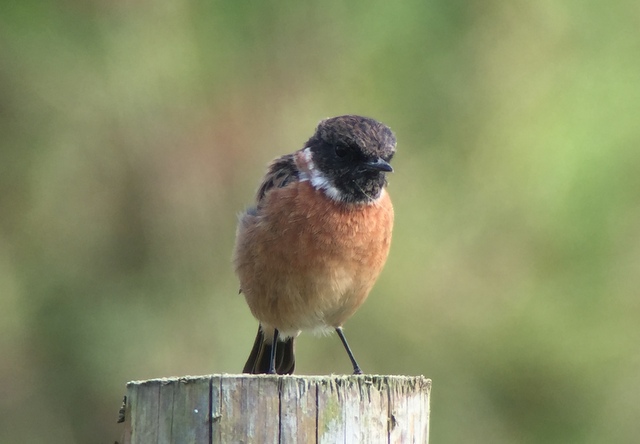 Stonechat – at least 6 at Kelling today, this one from the other day
Stonechat – at least 6 at Kelling today, this one from the other day
The warm sunny weather meant perfect conditions for raptors moving along the coast. While we were watching the Barred Warbler, we had seen a little kettle of nine Common Buzzards circling up over the fields beyond. It was to be a bit of a theme today. When we got back to the car, another two Common Buzzards drifted off the ridge on the edge of Kelling Heath and over the village. Later in the afternoon, we saw more kettles circling along the coast.
After lunch, we started to make our way back west. Stiffkey Fen was our next post of call. There were Long-tailed Tits calling from the trees as we made our way our way along the path. We could just see a large white blob out amongst the geese as we walked past the Fen, through the overgrown vegetation. From up on the seawall, everyone could see it was a Spoonbill. It was asleep at first, doing what every self-respecting Spoonbill likes to do most, but woke up a couple of times briefly, just long enough to flash its long, spoon-shaped bill. The yellow tip confirmed it was an adult.
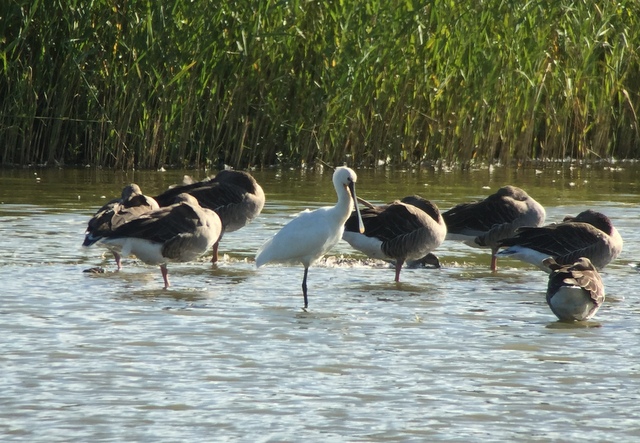 Spoonbill – during one of its waking moments, an adult
Spoonbill – during one of its waking moments, an adult
While we were watching the first Spoonbill sleeping, a second flew in from the direction of the saltmarsh. It circled over the Fen, dropping down towards the water. We could see it was a young bird from the black tips to its wings. Unfortunately it landed out of view behind the reeds. A Kingfisher called and flashed past upriver.
There was not much else of note out on the Fen. Once again, the water levels are too high here. There were lots of Greylag and Canada Geese and a respectable congregation of ducks, including a few more Pintail. Lapwing represented the bulk of the waders, plus a handful of Ruff and Black-tailed Godwits. A Greenshank was feeding in the saltwater channel on the other side of the seawall together with a Redshank, giving us a nice side-by-side comparison of the two species.
We walked round to the harbour, with the view out to Blakeney Point beyond looking beautiful in the sunshine. The tide was still out, but we could see lots of birds out on the mud. The large gathering of gulls included both Great and Lesser Black-backed Gulls, the latter’s custard-yellow legs glowing in the sun. There are already a good number of Brent Geese in here, plus there was a small group of Mute Swans out in the channel. When a small boat sailed past, a large flock of Wigeon took to the air and circled round over it. Pink-footed Geese were a big theme of yesterday, with many hundreds arriving in the afternoon. We had a couple more groups coming in over the harbour – heading off in different directions, both east and west along the coast.
The waders were mostly distant. Once again there were lots of Oystercatcher roosting on the mud and good numbers of Curlew. Another Greenshank was asleep in the channel in front of us, again with a Redshank for company. While we were standing there, we heard more Greenshank calling and seven more flew in over our heads and dropped down towards the Fen.
We still had time for one last stop on our way back, so we called in at Warham Greens briefly. Another Yellow-browed Warbler had been seen here earlier in the morning, but by the time we got there a few forelorn souls were searching in vain – it seemed to have moved off with one of the local Long-tailed Tit flocks a few hours earlier and no one seemed to know which way it had gone. We walked down to the end of the track and had a look in the sycamores. We saw a couple of Goldcrests on our way down and two Chiffchaffs flycatching in the late afternoon sun in the trees. We stopped to admire the big flock of Golden Plover out on the saltmarsh. Then it was time to call it a day.
















